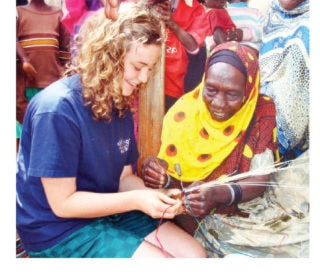For Dr. Allan Dickens, his family and his brother Stephen with daughter Chelsea, a chance to go to Kenya in November, 2010 was more than a chance to dodge the cold or see many exotic animals.
It was a chance for them to revisit their roots and to show their children where they spent the first 18 years of their lives.
The opportunity presented itself when their parents, Tony and Rose Dickens, were asked to return to Kenya, where they had spent 30 years serving with a mission organization, to give coverage for a couple who needed to return to America for 10 weeks.
Their first few days were spent in Nairobi where the children fed giraffes and watched as orphan baby elephants wallowed in a small water hole.
They marveled at the driving skill of the drivers in the midst of horrific traffic jams. Nairobi has completely outgrown the infrastructure which the British had left as their colonial legacy.
The next stop was the Rift Valley Academy, the school where they had graduated in the 1980s.
Needless to say the campus had evolved into a most beautiful place with an extraordinarily beautiful view of the Rift Valley dotted with extinct volcanoes, some of which they had climbed and explored in their younger years.
Masaai still herd their cattle on the valley floor sharing the vast grasslands with the lion, zebra, giraffe and gazelle.
From Kijabe they came to visit the retreat centre where their parents were working. This was a four-hour journey north west up the Rift Valley near a little town called Eldama Ravine.
Here they tasted what African life is all about. They were treated to traditional African food in the humble homes of some of the most gracious people they have ever met. One day was dedicated to walking through the shops which are called “dukas.”
Here they watched tailors sewing clothing, ironing their creations with charcoal irons. They watched in fascination as the local butcher sliced off a slab of meat from the carcass of a cow and using a cleaver on the end of a well worn stump, he filled their order of “nyama.”
Thursday is market day and what a colourful display of just about everything imaginable from used clothing and shoes to all the fruit and vegetables, which they were used to eating at home. The difference was that the fruit was tree ripened and so very flavourful.
The thing that impressed them most were the number of cellphones, which seemed to be at the ear of just about everyone you saw — from the shoeshine boy to the business man — just everyone has a phone. They use their phones to transfer money to each other, also a service which we in the west don’t even have at our disposal.
There were dozens of motorcycles, which the enterprising owners use as taxis carrying two passengers or three or four sacks of charcoal to market. Small three-wheeled taxis called “tuk tuk’s” were numerous in the major towns.
The children had opportunities to visit two orphanages where 150 children were being cared for by a staff of Kenyan dorm parents.
Another highlight was a visit to a Sudanese village where the elderly women make beautiful bowls and hot pads from reeds. The village was very near the equator at an altitude of more than 5700 feet above sea level.
The retreat centre with its six cabins also had a small herd of cows and a flock of chickens. The children took turns gathering eggs and milking the cows. Strawberries grow all the year round.
The final days were spent as true tourists, enjoying the vast expanses of the countries game parks. Amboseli Game reserve, at the foot of Mt. Kilimanjaro, boast some of the world’s largest herds of elephant.
The morning and evening game drives provided huge opportunities for the shutter bugs in the crowd.
The last part of their trip took them to the coast of the Indian Ocean. The bath tub warm water and expansive stretches of fine white sand with virtually no others to break the idyllic spell, made this part of their safari particularly memorable.
The villa where they stayed came with its own swimming pool and a staff who waited on them literally hand and foot.
No meal was just “ordinary.” The cuisine included fresh fish, shrimp and even octopus and squid.
Lunches were served in a thatched gazebo overlooking the ocean. The temperature was in the 30 degree range and coming back to Canada proved a real shock.
